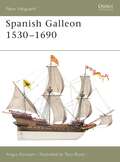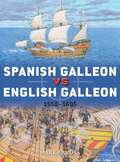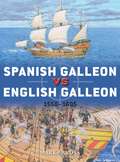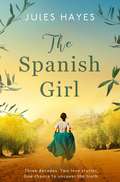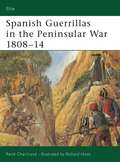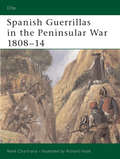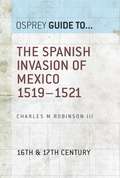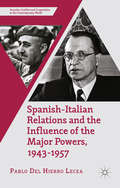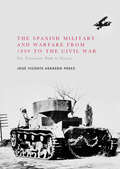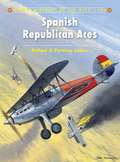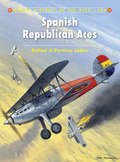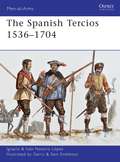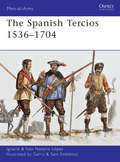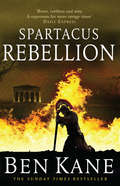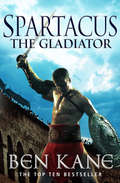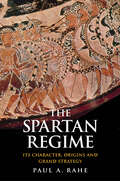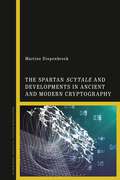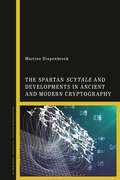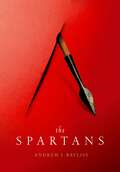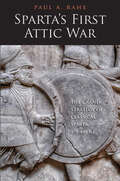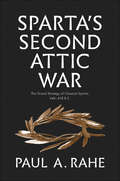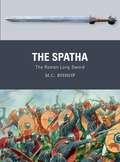- Table View
- List View
Spanish Galleon 1530–1690 (New Vanguard)
by Angus KonstamDuring the middle decade of the 16th century a new type of sailing vessel emerged, designed to carry the wealth of the Americas to Spain. This was the galleon, and over the next century these vessels would serve Spain well as treasure ships and warships, becoming a symbol of Spanish power and wealth during the period. The development and construction of the Spanish galleon are discussed in this book, and the ordnance and crewing needed to produce and maintain these stately vessels is covered. The author also examines the role of the galleon as a treasure ship, and describes how these ships were manned and fought in action.
Spanish Galleon vs English Galleon: 1550–1605 (Duel)
by Mark LardasBetween 1550–1600, Europe witnessed a rapid evolution in the art of ship design which enabled safer and more efficient transatlantic travel. This was the pinnacle of the Age of Discovery and Exploration for the European powers, in which the galleon played a crucial role. Galleons were both the main vessels in maritime commerce and the principal warships used by the opposing fleets throughout the Age of Exploration. This period also saw a large amount of naval combat, much of it between individual ships belonging to the competing powers of England and Spain as they sought to control and exploit the rich mineral, material, agricultural and human resources of the New World. The conflict between the English Sea Dogs and the Spanish Adventurers has been a source of fascination for over four centuries. This exciting addition to the Duel series explores how the galleons used by Spain and England were built and armed, and examines the effectiveness of the cannon they used. It also compares how they were sailed and manoeuvred, showing the strengths and weaknesses of each design, and explaining how these played out in several of their most prominent battles, including the Battle of San Juan de Ulúa, the fight between the Golden Hind and the Nuestra Señora de la Concepción, an action from the Spanish Armada, and the last fight of the Revenge.
Spanish Galleon vs English Galleon: 1550–1605 (Duel #106)
by Mark LardasBetween 1550–1600, Europe witnessed a rapid evolution in the art of ship design which enabled safer and more efficient transatlantic travel. This was the pinnacle of the Age of Discovery and Exploration for the European powers, in which the galleon played a crucial role. Galleons were both the main vessels in maritime commerce and the principal warships used by the opposing fleets throughout the Age of Exploration. This period also saw a large amount of naval combat, much of it between individual ships belonging to the competing powers of England and Spain as they sought to control and exploit the rich mineral, material, agricultural and human resources of the New World. The conflict between the English Sea Dogs and the Spanish Adventurers has been a source of fascination for over four centuries. This exciting addition to the Duel series explores how the galleons used by Spain and England were built and armed, and examines the effectiveness of the cannon they used. It also compares how they were sailed and manoeuvred, showing the strengths and weaknesses of each design, and explaining how these played out in several of their most prominent battles, including the Battle of San Juan de Ulúa, the fight between the Golden Hind and the Nuestra Señora de la Concepción, an action from the Spanish Armada, and the last fight of the Revenge.
The Spanish Girl: A completely gripping and heartbreaking historical novel
by Jules Hayes'A splendid story of heartbreaking consequences and ambition during the Spanish Civil War... A recommended read' Glynis Peters, bestselling author of The Secret Orphan***A country torn apart by war.Two love stories divided by decades.One chance to discover the truth... Feisty journalist Isabella has never known the truth about her family. Escaping from a dangerous assignment in the turbulent Basque country, she finds her world turned upside down, firstly by her irresistible attraction to the mysterious Rafael, and then by a new clue to her own past. As she begins to unravel the tangled story of her identity, Isabella uncovers a story of passion, betrayal and loss that reaches back to the dark days of Spain's civil war - when a passionate Spanish girl risked everything for her country, and for the young British rebel who captured her heart. But can Isabella trust the man she's fallen in love with? Or are some wartime secrets better left undisturbed...? Heartbreaking, gripping historical fiction about the tragedy of war, and the redemption of love. Perfect for fans of Angela Petch's The Tuscan Secret and Kathryn Hughes' The Letter. ***Praise for The Spanish Girl:'An outstanding read... Epic, personal, intimate and beautifully written' Lizzie Page, author of The Forgotten Girls'A compelling tale of friendship, love and loss. Impeccably researched, the story is full of surprises' Rhiannon Ward, author of The Quickening'A fabulous read of love, loss, loyalty and bravery set against the fascinating backdrop of the Spanish War. I was engrossed from the start and a must read for fans of dual timeline women's fiction' Suzanne Fortin, author of The Forgotten Life of Arthur Pettinger
Spanish Guerrillas in the Peninsular War 1808–14 (Elite)
by Richard Hook René ChartrandConstant Spanish guerrilla activity so drained the resources and diverted the attention of the French military that Wellington was able to advance against and overcome a numerically superior enemy. So many French soldiers were being used to counter the guerrillas and the threat that they posed that less than a third of the French army could be tasked with confronting Wellington. This book brings to life, for the first time, the formation, tactics and experiences of the Spanish guerrilla forces that fought Napoleon's army. Using much previously unpublished material, it offers a vivid description of the guerrilla and his lifestyle.
Spanish Guerrillas in the Peninsular War 1808–14 (Elite #108)
by Richard Hook René ChartrandConstant Spanish guerrilla activity so drained the resources and diverted the attention of the French military that Wellington was able to advance against and overcome a numerically superior enemy. So many French soldiers were being used to counter the guerrillas and the threat that they posed that less than a third of the French army could be tasked with confronting Wellington. This book brings to life, for the first time, the formation, tactics and experiences of the Spanish guerrilla forces that fought Napoleon's army. Using much previously unpublished material, it offers a vivid description of the guerrilla and his lifestyle.
The Spanish Invasion of Mexico 1519–1521 (Guide to... #60)
by Charles M. Robinson IIIThe Spanish conquest of Mexico was the most remarkable military expedition in history, and in achieving it, Hernan Cortes proved himself as one of the greatest generals of all time. This book explains the background of the Aztec Empire and of the Spanish presence in Mexico. It describes the lives of the Aztecs in their glittering capital and of the Europeans who learned to adapt and survive in an alien and often dangerous world. The invasion was a war between civilizations, pitting the fatalism and obsessive ritual of the Aztecs against soldiers fighting for riches, their lives, and eventually their souls.
Spanish-Italian Relations and the Influence of the Major Powers, 1943-1957 (Security, Conflict and Cooperation in the Contemporary World)
by Pablo Del Hierro LeceaSpanish-Italian Relations and the Influence of the Major Powers examines complex relations between Spain and Italy, beginning in 1943 and continuing until 1957, contending that the relationship cannot be examined in isolation and must be understood in its broader context.
The Spanish Military and Warfare from 1899 to the Civil War: The Uncertain Path to Victory
by José Vicente Herrero PérezThis book explores the attitudes of the Spanish army officer corps towards the evolution of warfare during the early decades of the twentieth century, and their influence on the armies of the Spanish Civil War. It examines how the Spanish military coped with technological innovations such as the machine gun and the tank, how it adapted the army´s battlefield doctrine to changes in warfare before the Civil War, and the influence of this doctrine on the outcome of the conflict. Of the different armed forces that fought in the Spanish Civil War, it is paradoxically the Spanish army that remains most forgotten - especially its military doctrine. Scholarship on the Spanish military in this period focuses on its politics, ideology and institutional reforms, touching upon 'hard' professional issues only superficially, if at all. Based on original research and using largely unstudied Spanish primary sources, this book fills a major scholarly gap in the history of the Spanish army and the Spanish Civil War.
Spanish Republican Aces (Aircraft of the Aces)
by Rafael A López Permuy Julio López CaeiroAt the start of the Spanish Civil War, most young fighter pilot officers joined the rebels, while the high ranking officers, grupo or escuadrilla commanders, and the NCOs, sergeants and corporals remained loyal to the government. Mostly flying the obsolete Nieuport Ni.52s these loyalists were soon outpaced by the more modern Fiat CR.32s and Heinkel He 51s. However, at this early stage of the war, there were several Republican airmen who became aces and famous in the process, despite the small numbers of enemy aircraft shot down. Widely speaking, the Republican military aviation did not keep an exhaustive record of individual shooting claims. However, sufficient documentation exists to make a reasonable assumption as to which pilots fall into the ace category. This volume details the exploits of those pilots, complementing previous works in the Osprey Aircraft of the Aces series on Nationalist CR.32 Aces and Polikarpov I-15, I-16 and I-152 Aces.
Spanish Republican Aces (Aircraft of the Aces #106)
by Rafael A López Permuy Julio López CaeiroAt the start of the Spanish Civil War, most young fighter pilot officers joined the rebels, while the high ranking officers, grupo or escuadrilla commanders, and the NCOs, sergeants and corporals remained loyal to the government. Mostly flying the obsolete Nieuport Ni.52s these loyalists were soon outpaced by the more modern Fiat CR.32s and Heinkel He 51s. However, at this early stage of the war, there were several Republican airmen who became aces and famous in the process, despite the small numbers of enemy aircraft shot down. Widely speaking, the Republican military aviation did not keep an exhaustive record of individual shooting claims. However, sufficient documentation exists to make a reasonable assumption as to which pilots fall into the ace category. This volume details the exploits of those pilots, complementing previous works in the Osprey Aircraft of the Aces series on Nationalist CR.32 Aces and Polikarpov I-15, I-16 and I-152 Aces.
The Spanish Tercios 1536–1704 (Men-at-Arms)
by Gerry Embleton Ignacio J.N. LópezA mixed infantry formation made up of about 3,000 men armed with pikes, swords and handguns, the innovative and influential tercio or 'Spanish square' was the basic combat unit of the armies of Spain throughout much of the 16th and 17th centuries. Arguably the first permanent tactical formation seen in Europe since the Roman cohort, the tercio was the forerunner of modern formations such as the battalion and regiment. The variety of different weapons fielded in the tercio meant the Spanish infantry could resist opposing cavalry forces while overcoming every kind of enemy infantry deployed against them. Featuring full-colour artwork and photographs of rare items held at the Spanish Army Museum, this study covers the whole period during which the tercios were active, opening with the third Italian war between the forces of France and the Holy Roman Emperor and concluding with the final transformation of the Spanish tercios into regiments in 1704.
The Spanish Tercios 1536–1704 (Men-at-Arms #481)
by Gerry Embleton Ignacio J.N. LópezA mixed infantry formation made up of about 3,000 men armed with pikes, swords and handguns, the innovative and influential tercio or 'Spanish square' was the basic combat unit of the armies of Spain throughout much of the 16th and 17th centuries. Arguably the first permanent tactical formation seen in Europe since the Roman cohort, the tercio was the forerunner of modern formations such as the battalion and regiment. The variety of different weapons fielded in the tercio meant the Spanish infantry could resist opposing cavalry forces while overcoming every kind of enemy infantry deployed against them. Featuring full-colour artwork and photographs of rare items held at the Spanish Army Museum, this study covers the whole period during which the tercios were active, opening with the third Italian war between the forces of France and the Holy Roman Emperor and concluding with the final transformation of the Spanish tercios into regiments in 1704.
Spare Brides
by Adele ParksHope. Glamour. Independence. A new era has begun… ‘A wonderfully absorbing tale of friendship, rich in period detail’ Stylist
The Spark Girl: A heart-warming tale of wartime adventure, romance and heartbreak.
by Fiona Ford'A compelling first novel which I promise you won't be able to put down' Daisy Styles, bestselling author of The Bomb Girls Can her fight for the country fix her broken heart? A knock on the door early one morning shouldn't be cause for concern but it is 1941, Britain is at war, and Kitty Williams's fiancé is far from home fighting Hitler with the Navy.As her heart is shattered hearing the news she had been dreading, Kitty becomes more determined than ever to do her bit for the war effort.Signing up to the Women's Army is just the sort of challenge Kitty needs but when bombs start to fall on her home town of Coventry, and allies turn against her, Kitty must find the strength she never knew she had to save her family, fix her broken heart and help her country to victory. The Spark Girl is an absorbing and poignant saga, perfect for fans of Daisy Styles, Kate Thompson and Ellie Dean. The second book in the series, The Spark Girl's Promise is now available for pre-order 'a fabulous debut from an immensely talented author' Annie Groves 'Ford gets to the heart of what it was like to live through the dangerous war years in this warm, captivating, down-to-earth story which is brimming with engaging characters, adventure, romance and heartbreak.' Lancashire Post 'Fiona Ford has written a charming and very appealing story...Kitty Williams is the girl we all want to be.' Swirl and Thread 'an enjoyable read with a twist towards the end to keep the reader engaged until the next one!' Jera's Jamboree
Spartacus: (Spartacus 2) (Spartacus #2)
by Ben KaneHe marches to freedom - or to bloody war. The epic story of Spartacus the legendary gladiator. From the Sunday Times bestselling author of Hannibal: Enemy of Rome and Spartacus: The Gladiator.The mighty slave army, led by Spartacus, has crushed all before it, scattering the legions of Rome. Now invincible, he marches towards the Alps and freedom.But storm clouds are growing on the horizon. Crassus, the richest man in Rome, has raised an army to rival Spartacus, and there are murmurings of rebellion in Spartacus’ own army.Spartacus, on the brink of glory, must make a crucial decision - to go forward over the Alps to freedom, or back to face the might of Rome and try to break its power forever.'Compulsive, relentless ... vividly recounted in muscular prose' Daily Telegraph'A brutal, blood-spattered novel' BBC History Magazine
Spartacus: (Spartacus 1) (Spartacus #1)
by Ben KaneThe first of two epic novels which tell the story of one of the most charismatic heroes history has ever known - Spartacus, the gladiator slave who took on and nearly defeated the might of Rome, during the years 73-71 BC.Historically very little is known about Spartacus. We know that he came from Thrace, a land north of Greece, that he once fought in the Roman legions and that, during two fateful years, he led a slave army which nearly brought Rome to its knees.In Ben Kane's brilliant novel, we meet Spartacus as he returns to Thrace, ready to settle down after a decade away. But a new king has usurped the throne. Treacherous and violent, he immediately seizes Spartacus and sells him to a Roman slave trader looking for new gladiators.The odyssey has begun which will see Spartacus become one of the greatest legends of history, the hero of revolutionaries from Karl Marx to Che Guevara, immortalised on screen, and now brought to life in Ben Kane's great bestseller - a novel which takes the story to its halfway point and is continued in Spartacus: Rebellion.Ben Kane was born in Kenya and raised there and in Ireland. He studied veterinary medicine and University College, Dublin, but after that he travelled the world extensively, indulging in his passion for ancient history. He lives in North Somerset with his wife and two young children.
The Spartan Regime: Its Character, Origins, and Grand Strategy (Yale Library of Military History)
by Paul Anthony RaheAn authoritative and refreshingly original consideration of the government and culture of ancient Sparta and her place in Greek history For centuries, ancient Sparta has been glorified in song, fiction, and popular art. Yet the true nature of a civilization described as a combination of democracy and oligarchy by Aristotle, considered an ideal of liberty in the ages of Machiavelli and Rousseau, and viewed as a forerunner of the modern totalitarian state by many twentieth-century scholars has long remained a mystery. In a bold new approach to historical study, noted historian Paul Rahe attempts to unravel the Spartan riddle by deploying the regime-oriented political science of the ancient Greeks, pioneered by Herodotus, Thucydides, Plato, Xenophon, and Polybius, in order to provide a more coherent picture of government, art, culture, and daily life in Lacedaemon than has previously appeared in print, and to explore the grand strategy the Spartans devised before the arrival of the Persians in the Aegean.
The Spartan Scytale and Developments in Ancient and Modern Cryptography
by Dr Martine DiepenbroekThis book offers a comprehensive review and reassessment of the classical sources describing the cryptographic Spartan device known as the scytale. Challenging the view promoted by modern historians of cryptography which look at the scytale as a simple and impractical 'stick', Diepenbroek argues for the scytale's deserved status as a vehicle for secret communication in the ancient world. By way of comparison, Diepenbroek demonstrates that the cryptographic principles employed in the Spartan scytale show an encryption and coding system that is no less complex than some 20th-century transposition ciphers. The result is that, contrary to the accepted point of view, scytale encryption is as complex and secure as other known ancient ciphers. Drawing on salient comparisons with a selection of modern transposition ciphers (and their historical predecessors), the reader is provided with a detailed overview and analysis of the surviving classical sources that similarly reveal the potential of the scytale as an actual cryptographic and steganographic tool in ancient Sparta in order to illustrate the relative sophistication of the Spartan scytale as a practical device for secret communication. This helps to establish the conceptual basis that the scytale would, in theory, have offered its ancient users a secure method for secret communication over long distances.
The Spartan Scytale and Developments in Ancient and Modern Cryptography
by Dr Martine DiepenbroekThis book offers a comprehensive review and reassessment of the classical sources describing the cryptographic Spartan device known as the scytale. Challenging the view promoted by modern historians of cryptography which look at the scytale as a simple and impractical 'stick', Diepenbroek argues for the scytale's deserved status as a vehicle for secret communication in the ancient world. By way of comparison, Diepenbroek demonstrates that the cryptographic principles employed in the Spartan scytale show an encryption and coding system that is no less complex than some 20th-century transposition ciphers. The result is that, contrary to the accepted point of view, scytale encryption is as complex and secure as other known ancient ciphers. Drawing on salient comparisons with a selection of modern transposition ciphers (and their historical predecessors), the reader is provided with a detailed overview and analysis of the surviving classical sources that similarly reveal the potential of the scytale as an actual cryptographic and steganographic tool in ancient Sparta in order to illustrate the relative sophistication of the Spartan scytale as a practical device for secret communication. This helps to establish the conceptual basis that the scytale would, in theory, have offered its ancient users a secure method for secret communication over long distances.
The Spartans
by Andrew J. BaylissThe image of Sparta, and the Spartans, is one dyed indelibly into the public consciousness: musclebound soldiers with long hair and red cloaks, bearing shiny bronze shields emblazoned with the Greek letter lambda. 'This is Sparta!', bellows Leonidas on the silver screen, as he decides to lead his 300 warriors to their deaths at Thermopylae. But what was Sparta? The myths surrounding Sparta are as old as the city itself. Even in antiquity, Sparta was a unique society, considered an enigma. The Spartans who fought for freedom against the Persians called themselves 'equals' or peers, but their equality was reliant on the ruthless exploitation of the indigenous population known as helots. The Spartans' often bizarre rules and practices have the capacity to horrify as much they do to fascinate us today. Athenian writers were intrigued and appalled in equal measure by a society where weak or disabled babies were said to have been examined carefully by state officials before being dumped off the edge of a cliff. Even today their lurid stories have shaped our image of Sparta; a society in which cowards were forced to shave off half their beards, to dress differently from their peers, and who were ultimately shunned to the extent that suicide seemed preferable. Equally appalling to us today is the brutal krypteia, a Spartan rite of passage where teenagers were sent into the countryside armed with a knife and ordered to eliminate the biggest and most dangerous helots. But the truth behind these stories of the exotic other can be hard to discover, lost amongst the legend of Sparta which was even perpetuated by later Spartans, who ran a thriving tourist industry that exaggerated the famed brutality of their ancestors. As Andrew Bayliss explores in this book, there was also much to admire in ancient Sparta, such as the Spartans' state-run education system which catered even to girls, or the fact that Sparta was almost unparalleled in the pre-modern world in allowing women a clear voice, with no fewer than forty sayings by Spartan women preserved in our sources. This book reveals the best and the worst of the Spartans, separating myth from reality.
The Spartans
by Andrew J. BaylissThe image of Sparta, and the Spartans, is one dyed indelibly into the public consciousness: musclebound soldiers with long hair and red cloaks, bearing shiny bronze shields emblazoned with the Greek letter lambda. 'This is Sparta!', bellows Leonidas on the silver screen, as he decides to lead his 300 warriors to their deaths at Thermopylae. But what was Sparta? The myths surrounding Sparta are as old as the city itself. Even in antiquity, Sparta was a unique society, considered an enigma. The Spartans who fought for freedom against the Persians called themselves 'equals' or peers, but their equality was reliant on the ruthless exploitation of the indigenous population known as helots. The Spartans' often bizarre rules and practices have the capacity to horrify as much they do to fascinate us today. Athenian writers were intrigued and appalled in equal measure by a society where weak or disabled babies were said to have been examined carefully by state officials before being dumped off the edge of a cliff. Even today their lurid stories have shaped our image of Sparta; a society in which cowards were forced to shave off half their beards, to dress differently from their peers, and who were ultimately shunned to the extent that suicide seemed preferable. Equally appalling to us today is the brutal krypteia, a Spartan rite of passage where teenagers were sent into the countryside armed with a knife and ordered to eliminate the biggest and most dangerous helots. But the truth behind these stories of the exotic other can be hard to discover, lost amongst the legend of Sparta which was even perpetuated by later Spartans, who ran a thriving tourist industry that exaggerated the famed brutality of their ancestors. As Andrew Bayliss explores in this book, there was also much to admire in ancient Sparta, such as the Spartans' state-run education system which catered even to girls, or the fact that Sparta was almost unparalleled in the pre-modern world in allowing women a clear voice, with no fewer than forty sayings by Spartan women preserved in our sources. This book reveals the best and the worst of the Spartans, separating myth from reality.
Sparta's First Attic War: The Grand Strategy of Classical Sparta, 478-446 B.C. (Yale Library of Military History)
by Paul Anthony RaheA companion volume to The Spartan Regime and The Grand Strategy of Classical Sparta that explores the collapse of the Spartan†‘Athenian alliance During the Persian Wars, Sparta and Athens worked in tandem to defeat what was, in terms of relative resources and power, the greatest empire in human history. For the decade and a half that followed, they continued their collaboration until a rift opened and an intense, strategic rivalry began. In a continuation of his series on ancient Sparta, noted historian Paul Rahe examines the grounds for their alliance, the reasons for its eventual collapse, and the first stage in an enduring conflict that would wreak havoc on Greece for six decades. Throughout, Rahe argues that the alliance between Sparta and Athens and their eventual rivalry were extensions of their domestic policy and that the grand strategy each articulated in the wake of the Persian Wars and the conflict that arose in due course grew out of the opposed material interests and moral imperatives inherent in their different regimes.
Sparta's Second Attic War: The Grand Strategy of Classical Sparta, 446-418 B.C. (Yale Library of Military History)
by Paul Anthony RaheIn a continuation of his multivolume series on ancient Sparta, Paul Rahe narrates the second stage in the six-decades-long, epic struggle between Sparta and Athens that first erupted some seventeen years after their joint victory in the Persian Wars. Rahe explores how and why open warfare between these two erstwhile allies broke out a second time, after they had negotiated an extended truce. He traces the course of the war that then took place, he examines and assesses the strategy each community pursued and the tactics adopted, and he explains how and why mutual exhaustion forced on these two powers yet another truce doomed to fail. At stake for each of the two peoples caught up in this enduring strategic rivalry, as Rahe shows, was nothing less than the survival of its political regime and of the peculiar way of life to which that regime gave rise.
The Spatha: The Roman Long Sword (Weapon)
by M.C. BishopAdopted from the Celts in the 1st century BC, the spatha, a lethal and formidable chopping blade, became the primary sword of the Roman soldier in the Later Empire. Over the following centuries, the blade, its scabbard, and its system of carriage underwent a series of developments, until by the 3rd century AD it was the universal sidearm of both infantry and cavalry. Thanks to its long reach, the spatha was the ideal cavalry weapon, replacing the long gladius hispaniensis in the later Republican period. As the manner in which Roman infantrymen fought evolved, styles of hand-to-hand combat changed so much that the gladius was superseded by the longer spatha during the 2nd century AD. Like the gladius, the spatha was technologically advanced, with a carefully controlled use of steel. Easy maintenance was key to its success and the spatha was designed to be easily repaired in the field where access to a forge may have been limited. It remained the main Roman sword into the Late Roman period and its influence survived into the Dark Ages with Byzantine, Carolingian and Viking blades. Drawing together historical accounts, excavated artefacts and the results of the latest scientific analyses of the blades, renowned authority M.C. Bishop reveals the full history of the development, technology, training and use of the spatha: the sword that defended an empire.
